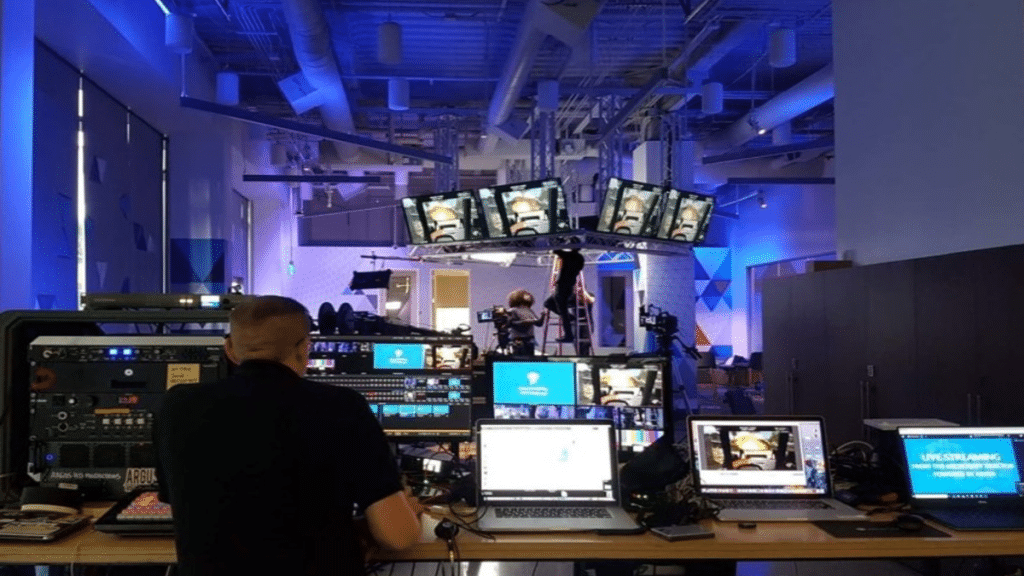Lighting plays a crucial role in film and video production, particularly in the unique environment of San Francisco. This article aims to provide insights and tips for mastering lighting techniques in video production, highlighting the importance of lighting and its impact on capturing the essence of the city.
Understanding the Basics of Lighting
To excel in lighting for video production in San Francisco, it is essential to grasp key lighting terms and concepts. Understanding terms like key light, fill light, and backlight is fundamental to create visually captivating scenes. Familiarize yourself with the lighting equipment and tools commonly used, as they play a vital role in achieving desired lighting effects. Additionally, controlling light quality, direction, and intensity is crucial to capture the diversity of San Francisco’s landscapes and settings.
Natural Lighting Techniques
Harnessing natural light is often a valuable approach in video production. The city’s unique lighting conditions can provide stunning opportunities. Utilize the sun’s position and angle to your advantage, capturing the distinct lighting that San Francisco offers. Modify natural light using reflectors, diffusers, and bounce boards to achieve the desired effects and enhance your video production.
Artificial Lighting Techniques
In addition to natural light, artificial lighting is commonly used in San Francisco video production. Familiarize yourself with different types of artificial lighting, such as tungsten, LED, and fluorescent, and their specific qualities. Setting up a three-point lighting system, including key light, fill light, and backlight, is a standard technique to achieve desired visual effects. Explore additional techniques like high-key lighting, low-key lighting, and silhouette lighting to enhance the visual storytelling in San Francisco video production.
Controlling Light Quality and Mood
Moreover, exploring different shooting locations, like iconic landmarks and vibrant neighborhoods, adds depth and authenticity to video productions. Collaborating with local talents, from actors to musicians, enhances the narrative and cultural richness, making each project a true reflection of the city’s diversity. Continuously pushing boundaries in techniques and equipment ensures staying ahead in the ever-evolving field of video production.
Creating Depth and Dimension with Lighting
Moreover, incorporating dynamic camera movements, such as crane shots or tracking shots, adds an immersive element to San Francisco video production, amplifying the viewers’ experience. By strategically placing light sources and leveraging the city’s architecture, you can create stunning silhouettes and shadows, further enhancing the overall visual impact. Remember to experiment with different angles, perspectives, and framing techniques to highlight the unique features of San Francisco’s landscapes, buildings, and people. These meticulous considerations contribute to the creation of captivating and memorable videos that truly capture the essence of the city.
Mastering Lighting Ratios and Exposure
Understanding lighting ratios is essential for achieving the desired contrast and mood. Practice techniques that allow you to achieve proper exposure in different lighting conditions, capturing the nuances of the city’s varied landscapes. Balancing highlights and shadows ensures a well-exposed and visually appealing image that showcases the beauty of the city.
Lighting for Different Genres and Styles
Adapting lighting techniques to suit different film genres is crucial in the vibrant and diverse cultural scene of San Francisco. Explore lighting aesthetics and styles such as film noir, high-contrast lighting, and naturalistic lighting that complement the artistic expression in San Francisco video production. Maintain consistency in lighting across different scenes and locations to ensure visual coherence in your video.
Working with Lighting in Challenging Environments
Additionally, mastering the art of balancing artificial and natural lighting becomes essential when tackling San Francisco’s diverse weather patterns. Adapting to sudden fog, mist, or dramatic sunlight can be achieved through techniques like light diffusers, reflectors, and dynamic exposure control. Familiarize yourself with weather apps and keep backup plans in place for unexpected changes. Embrace the challenge of capturing the city’s essence, whether it’s the ethereal glow of the Golden Gate Bridge at dusk or the bustling nightlife of the Mission District. Flexibility and adaptability are key in achieving stunning visuals amidst San Francisco’s ever-changing outdoor conditions.
Collaborating with the Cinematographer and Production Team
Collaboration and communication with the cinematographer and production team are essential in capturing the essence of San Francisco through lighting. Work closely with the team to ensure that lighting supports the storytelling and captures the unique spirit of the city. Adapt lighting techniques to complement other aspects of production, such as production design and costume design, to create a cohesive visual narrative for corporate video production in San Francisco.
In conclusion, mastering lighting techniques is crucial for a successful video production. Recap the key techniques covered in this article and emphasize the importance of practice, experimentation, and developing a personal style that aligns with the diverse and captivating visuals of San Francisco. Lighting is a crucial element in enhancing visual storytelling and capturing the essence of the city in video production. Embrace the power of lighting to elevate your video production in the vibrant city of San Francisco.
